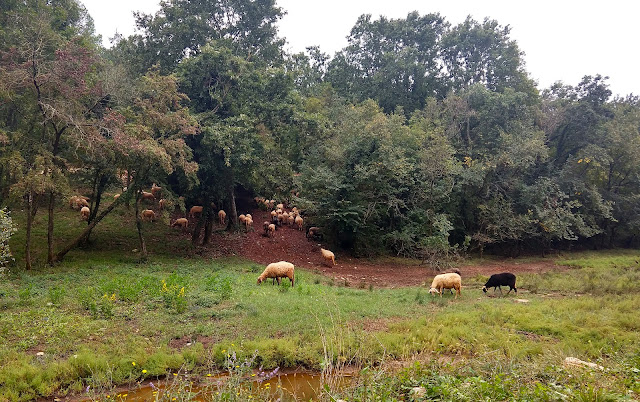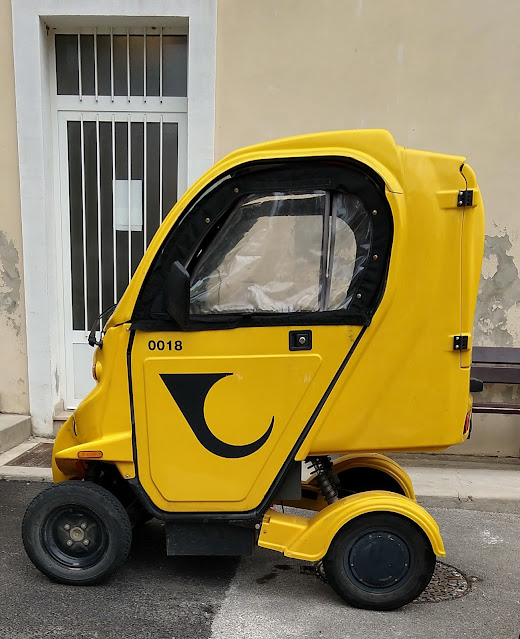John Galsworthy
 |
| View of Umag from its Lovrečica suburb |
The majority of the Istrian Coastal Area is populated with Croats – anywhere from 55-65% of them depending on which town you are in. Their populace is interspersed with 15-18% Italians, 3-4% Serbs, 2-3% Slovenes, 1-2% Bosnians, and 1% Albanians. Interestingly however, nearly 100% of the inhabitants speak Italian, a wink to the long history of the Venetian Empire's hold on this region for over 450 years.
Umag
We only biked through Umag, not stopping for very long
so I don’t have much to say about it, other than it resembled many of the other
places we visited on this trip. A rather
compact old town with ancient protective walls, by the sea, and bordered,
inland, by olive orchards, and vineyards.
While there are seemingly hundreds of vineyards
scattered all across the Istrian region, some of the best lie within the vicinity
of Umag.
We rode down a long promenade where many people
enjoyed picnicking, cycling, volleyball, walking, swimming, reading on benches,
playing with their children, etc. Eventually
this 15.5 miles (25km) promenade will be extended to around 25 miles (40km), making it the
longest in the Adriatic.
What is now a peninsula, used to be an island, and the
settlement itself was situated at the end of the port of Umag. The partially
preserved town walls - with the town gate and a draw-bridge were built in the
10th century. It is protected by a 1,325 feet (404m) breakwater for
which construction began in 1825.
Of all the small towns I rode through along this coast, this one seemed the most active as it pertained to fishing. Men repairing nets, boats coming in and out, fish in buckets on the dock surveyed by many begging seagulls.
 |
| Large shrine along the road |
 |
| Shepherd with his two acolytes |
 |
| Very friendly canines indeed |
 |
| Finally get to see the calm flock they are herding |
As I cycled through this agricultural area in early fall, I saw farmers checking their olive or grape crops, preparing and planning for the upcoming harvesting season. Should you be here after harvest, it would be a great time to do olive oil or wine tastings. Should you be here around early spring, it would be time to try some špaleta. Should you be here during the summer, clams are at their optimum. There is something great tasting for each season but I’ll only address špaleta which is a prosciutto-like dried pork shoulder that is cured over the winter months and is ready to eat much sooner than prosciutto, as it is smaller and easier to cure.
The famously strong bora wind, meat and salt come together to create špaleta, the ambassador of Istrian cuisine. It is first salted and then left to the mighty bora, but unlike prosciutto, it is dried with the skin on. Since it is smaller than prosciutto and has more bones, špaleta ripens earlier.
Špaleta is a traditional delicacy and the custom is to bring it to church at Easter, to be blessed before eating, even if not completely dry. While in central Istria boiled pork shoulder or špaleta is eaten for Easter breakfast, western and southern Istria prefer it fried. For that, the špaleta is sliced very thinly otherwise it becomes hard when it cools down. It is then fried in olive oil for about ten seconds on each side. Malvasia wine is then added and the špaleta is simmered for a few more seconds. It is best served with frittata and wild local asparagus.
 |
| Spaleta ready earlier than prosciutto due to its smaller size Usually first blessed and eaten on Easter Day |
 |
| Served the northern way with frittata and asparagus |
 |
| Somewhat abandoned garden by the Adriatic Sea |
 |
| Small regatta |
 |
| Olives are ready in the fall - very soon |
Umbrella Streets
It all started back in 2011 when a Portuguese design
firm collaborated with the local government to create a small installation on a
narrow street in Agueda, Portugal. Inspired by the iconic children’s character
Mary Poppins and her magical floating umbrella, the installation featured
hundreds of colorful umbrellas suspended above the street. The Umbrella Street
was an instant hit. Pictures of this vibrant scene spreading like wildfire all
over the internet.
Over time, the Umbrella Street became an even bigger
draw, attracting tourists from all over the world. The installation became a
symbol of Agueda and a local point of pride, with residents proudly displaying lit
umbrellas on their balconies or donning umbrella hats. If you'd like to see it in person, plan accordingly because you can only see them
from July 1st to September 30th.
If you can’t make it to Agueda in the summer, they also
have a Christmas edition. The winter installation
is part of the Christmas magic, with illuminated white umbrellas and a red
carpet creating the perfect color combination for that festive season.
Novigrad followed suit in 2013 (but their installation stays up through October) first hanging umbrellas
during a summer street festival. Their
hanging umbrellas fit perfectly into the scenery of the old town nucleus, and
those who love photography and beautiful panorama have been given a perfect background
for vibrant photos even on a cloudy day.
Above your head, the sky is filled with color. Light filters down
through row after row of perfectly positioned umbrellas, a cheerful addition to
the surrounding.
So popular it became, the Umbrella Street’s success
has inspired similar installations in other countries too: Canada, Colombia, Czech Republic, England, France, Greece, Indonesia, Ireland, Israel, Italy, Japan,
Jordan, Mexico, Puerto Rico, Romania, Spain, Thailand, Turkey, etc.
Creating a colorful sky while offering needed shade on hot days, each umbrella street is different and a bit unique – some with semi-transparent umbrellas (Portugal), others with various shades of green to make it look like you are in a forest (Japan), only a couple of colors, orange + red (England), many colors (Croatia), installed on arches (Dubai) instead of flat, each umbrella a rainbow (Turkey), hot pink only (Puerto Rico), installed upside down rather than right side up (Indonesia), or red and white only (Romania).
 |
| The umbrellas of Novigrad |
.jpg) |
| Biking under the umbrellas of Novigrad |
Located in the intimate surroundings of western
Istria, where the river Mirna meets the Adriatic Sea, Novigrad is a true gem,
hiding within its city walls the inimitable Mediterranean charm, all the
hospitality of a small fishing town and exquisite cuisine. Bordered by boundless
blue-green landscapes, relish in the smell of the sea mixed with centuries-old
pine trees and enjoy the moment, lulled by the sound of waves lapping at your feet
and birds chirping.
The first written reference to the city goes back to
the distant 599 CE. Novigrad was founded on the grounds of several villages
that are known to have existed on this same land in the past- Neapolis in the 7th
century, Civitas Nova in the 9th century, and ancient Emona in the
12th century.
All of this to say that Novigrad’s background is
filled with a rich and turbulent past. However, the peninsula on which the
old town emerged is shrouded in secrets, and it is still not clear how the town
came to be.
Experts believe that, initially, a Roman villa,
similar to many others discovered in the vicinity, was built on the peninsula.
Because of the peninsula’s favorable position in terms of defense, a castrum or
military settlement sprung up around the villa in late Antiquity,
and from the 4th to the 7th century, it gradually
developed into a town.
Novigrad, together with the entire Istrian west coast,
was subjected to pirate attacks in the 10th century. Considering the
growing aspirations of the Venetian Republic towards Istrian coastal
towns, Novigrad was forced to swear allegiance to Venetian rule from which it
tried to free itself without success in 1270. Defense walls, parts of which can
be seen today, were erected during the Venetian era.
The plague raged in Novigrad from the 13th to
17th centuries; wars, in the 16th century; and malaria,
in the 19th century. In the 16th and 17th centuries
the town was almost depopulated, and only in the late 19th century
did it gradually begin to revive and prosper with the development of tourism
that was then affected by the two world wars.
Novigrad’s folks claim that this area is the cleanest part
of the Adriatic Sea so go enjoy a nice swim…
 |
| Interesting tiny four-wheel postal vehicle |
 |
| Red seaweed piling up on the shore |
.jpg) |
| Enjoying final dinner of the trip - scampi and braised veggies Without truffles! |
 |
| Last morning on wheels. Lovreciča having a coffee by the beach. |
No comments:
Post a Comment
We are always happy to hear from you but at times it may take a while to get a reply - all depends if we have access to the internet.